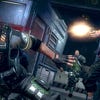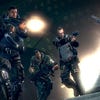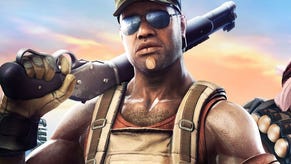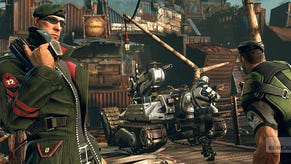Brink
Smart casual?
If Security makes it through that, the next goal is to use a crane to lift the robot to the final area. Here the bio-weapon, vaccine or whatever it is can be exposed by cutting through the side of a container.
All the levels we've seen and played so far follow this pattern: multiple objectives, each flowing into the next, each requiring a specialist (the Soldier plants bombs, the Engineer operates the crane, etc) and each benefiting from organisation, selfless actions and clever use of the environment.
Traditional team games - especially first-person shooters - struggle to get people to do the last three of those things, and one of Brink's goals is to overcome this. On the QuakeCon evidence it stands a good chance.
When our Security team struggles to breach the metal door on Container City we switch to the Medic class to offer support. We're tossing health packs to downed team-mates partly because it seems logical, but partly because the mission wheel - the slick one-button menu that shows you available objectives as you play - shows that it confers a lot of experience points.
Likewise, when we do break through and the trundling robot comes under sustained fire, it seems like a good time to opt for the Engineer and break out some unmanned turret guns to beef up our rearguard. Thanks to SMART it's possible to climb up a container away to the right of the metal door and provide overwatch for the slow-moving robot, too. When enemies appear on a platform nearby it's easy to vault over there and butt them in the face with a rifle.
You're not always playing with a full complement of human team-mates or enemies so the AI fills in the gaps and already does a solid job. While Wedgwood is demonstrating the Aquarium level he thinks he's coming under fire from an enemy on a raised turret so he climbs onto a pillar, leaps to the gangway and turns on his aggressor - only to discover it's one of his own men, and he was actually supporting him by taking out enemies approaching through a nearby door. Wedgwood says the developers teach the AI tactics and how each system works but they are constantly surprised at how well they adapt and improvise.
QuakeCon also sees Splash Damage unveil pre-order incentives for the US market - and we're told to expect these in Europe too, in some form. Each package gives you a special weapon and unique clothing items, and while the Psycho and Spec Ops bundles look good we expect the Fallout and DOOM packs (complete with Vault 101 tattoos, UAC body armour t-shirts and the like) to prove most popular.
The more we play Brink, the more it comes together. Splash Damage jokes that it bribes people to help each other out - but this technique works. It sounds weird being able to do parkour stuff automatically by holding a button - but it works.
It's hard to imagine how much story can be conveyed by cut-scenes full of custom characters - but they work too, hinting at mysteries on the horizon at Founders' Tower, the spire that's visible in every skyline.
Splash Damage has made popular games before - Wolfenstein: Enemy Territory is in the top three most-played online PC shooters to this day, Wedgwood claims - but Brink looks well on course to be its best yet. And who needs ladders, anyway?
Brink is due out for PC, PS3 and Xbox 360 in spring 2011.




















